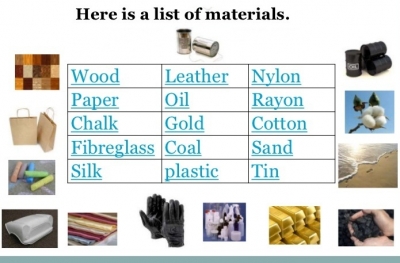
MATERIALS
Almost everything around us is made from some sort of material. Each has different properties, such as strength or flexibility, which makes it useful for making particular products. Some materials, such as wool or stone, grow or occur naturally. Synthetic materials are manufactured. Composite materials combine the properties of two or more materials to achieve the best possible product.
- SILK: This natural fibre is made from the cocoon of the silkworm. Each cocoon may produce 3 km (2 miles) of silk. Silk can be woven into an extremely fine fabric, and is prized for its texture and its shiny appearance.
- CONCRETE: Concrete is made by mixing sand, gravel, cement, and water. It is a liquid when freshly made, so it can be poured into a mould, where it sets to form an extremely hard and durable material.
- KEVLAR: A light, flexible, synthetic material, Kevlar is used for protective clothing, such as bulletproof vests. Kevlar molecules are arranged in long chains with strong bonds between them, which makes Kevlar five times stronger than steel.
- WOOL: This natural material comes from the fleece of sheep. The structure of its fibres means wool has a tendency to shrink, so it is often mixed with synthetic fibres to make easy-care fabrics.
- CARBON COMPOSITES: These materials are strong and light and can be turned into complex shapes, such as sports equipment. They are made from the carbon byproducts of coal, oil, and natural gas.
- METAL: When heated, metals can be shaped into anything from a paperclip to an aircraft. They are also good conductors of heat and suitable for carrying electricity.
- PLASTIC: This group of synthetic materials is made from petrochemicals (derived from crude oil). They are strong, light, cheap to make, and can be shaped into flexible sheets, films, or fibres.
- GLASS: This transparent ceramic is made by fusing sand, limestone, and soda at high temperatures, or by recycling old glass. Molten glass can be shaped in many ways, such as into windows, lenses, and threads for optical fibres.
- LYCRA: Synthetic fabrics are designed to have better properties than natural materials, such as cotton. Lycra is a stretchy fabric that keeps its original shape, making it perfect for sports clothes.
- RUBBER Natural rubber is an elastic material made from latex, a milky fluid from the rubber tree. Synthetic rubber is made from petrochemicals. Rubber is used in tyres and for waterproofing fabrics.
- NYLON: Developed in 1938, nylon was the first synthetic fabric. It can be produced in extremely fine threads, is cheap to manufacture, and was first used as a replacement for silk in stockings and parachutes.
- CERAMIC: Ceramic materials are made by heating different types of clay to a high temperature. China, bricks, tiles, cement, and glass are all ceramics. These materials are hard, brittle, and resistant to heat.
- WOOD: Wood is a strong material compared to its weight, and is a good building material. It is also used for furniture and art objects because of its attractive texture. It is referred to as hardwood or softwood, depending on the type of tree it comes from.
- COTTON: Cotton is a natural material produced from the long, flexible fibres in the fluffy seedpods of the cotton plant. The fabric is soft, comfortable to wear, and there is no static build-up as there is with some synthetic fabrics.
- STONE: Stone is a natural material quarried from the earth. It is hard and heavy and can withstand great pressure. Stone may be cut using diamond saws or extremely high-pressure jet of water.
Picture Credit : Google




